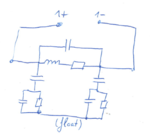irisaru
Newbie level 6
Dear all,
I am simulating the inductance and coupling coefficient of transformer using ADS. My procedure consists of three steps. First, I create a transformer using CoilSys in ADS and then simulate its S-parameter, then I separate this transformer into two inductors and simulate their S-parameter. After that, based on S-parameter I calculate the inductance of two inductors in two cases: (1) transformer (2) two separated inductors then I use the T-model of transformer to determine the mutual inductance and coupling coefficient.
Theoretically, inductance of inductor is determined using the equation:
L = imag(Z_ind)/(omega)
I found that the S11 = (Zin-Z0)/(Zin+Z0) => Zin = Z0*(1+S11)/(1-S11) when the other ports are matched. Furthermore, the Zin of the two-port inductor = Z0 + Z_ind, so we can find the Z_ind of inductor using S-parameter and then calculate the inductance using the previous equation.
However, I have read in one ADS application note that there are equations to determine the inductance of inductor
(https://muehlhaus.com/support/ads-application-notes/functions-in-ads)
They said that we can use stoz function to translate the S-parameter to Z-parameter and then thank to the equation: Zseries = (Z11*Z22 - Z12*Z21)/Z21, they use this impedance to calculate the inductance.
I have a question that does the Z11 from stoz() function different from the Zin, which is calculated from S11 and another question is what Zseries means and why do we use this impedance to calculate the inductance. I found that the inductance, calculated from Zseries and Zin are quite similar, and these results are more different from the inductance, determined from Z11_stoz.
Would you please advise me or give me some documents to solve this problem.
Thank you very much.
I am simulating the inductance and coupling coefficient of transformer using ADS. My procedure consists of three steps. First, I create a transformer using CoilSys in ADS and then simulate its S-parameter, then I separate this transformer into two inductors and simulate their S-parameter. After that, based on S-parameter I calculate the inductance of two inductors in two cases: (1) transformer (2) two separated inductors then I use the T-model of transformer to determine the mutual inductance and coupling coefficient.
Theoretically, inductance of inductor is determined using the equation:
L = imag(Z_ind)/(omega)
I found that the S11 = (Zin-Z0)/(Zin+Z0) => Zin = Z0*(1+S11)/(1-S11) when the other ports are matched. Furthermore, the Zin of the two-port inductor = Z0 + Z_ind, so we can find the Z_ind of inductor using S-parameter and then calculate the inductance using the previous equation.
However, I have read in one ADS application note that there are equations to determine the inductance of inductor
(https://muehlhaus.com/support/ads-application-notes/functions-in-ads)
They said that we can use stoz function to translate the S-parameter to Z-parameter and then thank to the equation: Zseries = (Z11*Z22 - Z12*Z21)/Z21, they use this impedance to calculate the inductance.
I have a question that does the Z11 from stoz() function different from the Zin, which is calculated from S11 and another question is what Zseries means and why do we use this impedance to calculate the inductance. I found that the inductance, calculated from Zseries and Zin are quite similar, and these results are more different from the inductance, determined from Z11_stoz.
Would you please advise me or give me some documents to solve this problem.
Thank you very much.

